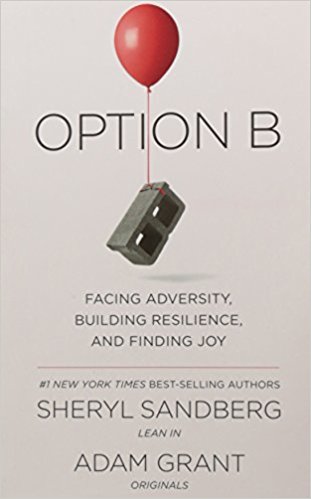Sheryl Sandberg and Adam Grant’s Option B: Facing Adversity, Building Resilience, and Finding Joy, Book Review
 Sheryl Sandberg became a model in an arena she would likely never desire. A mentor and guide for western women whose wildly popular TedTalk led to the New York Times bestseller Lean In: Women, Work, and the Will to Lead, Sandberg is a powerful figure to whom many people turn for wisdom and guidance in the realms of social media, women’s leadership, and personal growth.
Sheryl Sandberg became a model in an arena she would likely never desire. A mentor and guide for western women whose wildly popular TedTalk led to the New York Times bestseller Lean In: Women, Work, and the Will to Lead, Sandberg is a powerful figure to whom many people turn for wisdom and guidance in the realms of social media, women’s leadership, and personal growth.
But in 2015, many people began to turn to Sandberg for wisdom and guidance through grief. A Facebook post created one month after the shocking and untimely death of her husband while they vacationed in Mexico was a treasure of vulnerability. Thirty days “sadder” and “wiser” after this initial period of mourning, Sandberg shared with millions of readers her entry into the wildness of grief and loss.
Two years later, she joined with her friend Adam Grant, a Professor of Psychology at The University of Pennsylvania’s Wharton School of Business, to produce another New York Times bestseller. Their Option B: Facing Adversity, Building Resilience, and Finding Joy is their “attempt to share what we’ve learned about resilience.” Sandberg’s experience of grieving the los of her husband is the main narrative used to weave together Grant’s extensive research on resilience and deeply moving stories of profound resilience he has gathered from across the globe.
As a lesson book designed to teach readers how to build resilience Option B is strong; as an inspirational contemplation of the power of resiliency, it is even better.
But as a book for the bereaved, it is less beneficial.
Building on Martin Seligman’s powerful work on the “3 Ps” of pessimism (personalization, pervasiveness, and permanence), Sandberg and Grant present a multitude of stories detailing people facing atrocious adversities and still building resilience (“the strength and speed of our response to adversity”). They also present some ways in which we can build resiliency. I appreciate that Sandberg repeatedly introduces issues of economic and social challenges to adversity, owning that her position of privilege affords her resources unavailable to the vast majority of our globe’s population. I also admire that Sandberg is donating all of her income from the book to OptionB.Org, a nonprofit initiative to help people build resilience and find meaning in the face of adversity.
These are wonderful gifts. We can each benefit from learning how to build resiliency.
But I am not sure that we need to push ourselves or one another into resiliency during the acute periods of grief. As Sandberg’s rabbi instructed her, we must “lean into the suck” rather than turn away from it.
Most helpful amongst the grief guidance in this volume are:
- The reminder that “There is no right or proper way to grieve or face challenges, so we don’t have perfect answers. There are no perfect answers.”
- A discussion of the very important topic of how to be there for people in challenging situations, to not ignore the elephant in the room.
- The guidance that ““There’s no one way to grieve and there’s no one way to comfort.”
Least helpful in terms of grief is use of terms such as “overcoming grief.” Most of us who have lost someone dear to us recognize that we do not find or create closure, no matter how resilient we are. We do not become finished with grief. We are absolutely and irrevocably changed through our grieving. No tools for resilience can help us avoid those changes.